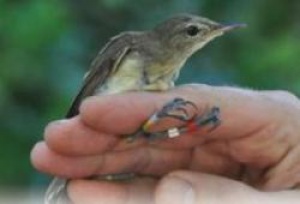Successful translocation of the Seychelles Warbler

Frégate Island is now home to the Seychelles Warbler (Acrocephalus sechellensis) – the 100th bird on their list. A translocation from Cousin Island Special Reserve was a great success and the new population has adapted extremely well, with the birds dispersing widely over the island and displaying for mates.
The translocation took place on December 7 and 14, 2011 and a total of 59 birds were transferred. After the birds were caught on Cousin, each bird was individually packed into cardboard boxes, brought to Frégate by helicopter, and released on the same day. The warblers were released near to the tennis court, an area previously identified as a “high quality” habitat during a pre-translocation survey. All the birds appeared fit and healthy upon release with no signs of injuries.
After the translocation, the warblers spread quickly away from the release site and within a day or two, these intriguing passerines were all over the island. These charming little birds have lovely calls and are easily attracted to the observer by whistling and phishing. The objective of the translocation is to establish another breeding population of the once critically-endangered Seychelles warbler, allowing the species to be down-listed from “vulnerable” to “near threatened” and removed from the BirdLife International List of Threatened Bird Species of the World.
RELEASE OF 30 YOUNG ALDABRA GIANT TORTOISES
Frégate Island has the second largest population of Aldabra Giant Tortoises, with approximately 2,000 free-roaming individuals. These tortoises are capable of growth throughout their life, if conditions permit, and can live to be 150 years or older. The average weight of males is 250 kg and females 150 kg. They are often found in numbers in shady areas during the heat of the day. The tortoises on the island are not tame or domesticated, but are generally indifferent to the presence of people. When frightened, tortoises quickly pull their heads into their shell, making a hissing sound as they expel air from their lungs.
ADVERTISEMENT
On Frégate Island, baby tortoises are kept in a pen for protection, where they are spoiled with plenty of leaves, fruits, and fresh water. Once they are old enough or reach a certain size, they are released into the wild. The release happens twice a year, usually during the festive season for the Christmas and New Year program.
On December 23, 2011 and January 1, 2012, the ecology team, along with Fregate Island Private’s Managing Director and guests, released a total of 30 Aldabra Giant Tortoises at Anse Parc area. Immediately after the release, the tortoises started to explore the area, roaming around the lawn and feeding on new leaves. They are being monitored and have adapted to their new surroundings with ease.
MIGRANT BIRDS ON FREGATE ISLAND
Birding on Frégate the last few months has provided some special sightings, including species that have not been recorded here before, although they have been recorded on the island previously. A female Garganey has made herself at home since November in the pond next to the marina. She was very skittish at first, but these days pays scant attention to humans and goes about her business as if nobody is there. December saw the arrival of two blue-cheeked bee-eaters, with their characteristic calls alerting their presence. They were around for a few days before disappearing from the plateau in the area of the spa and Glacis Cerf.
Both frigate bird species were regularly seen patrolling over the island in December, with more than 20 individuals being seen together on a number of occasions. Cuckoos have made their annual return to Frégate with four common cuckoos seen at different locations around the island. Once again, Fregate looks forward to finding some new and interesting species in the next couple of months.

